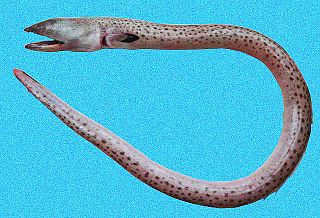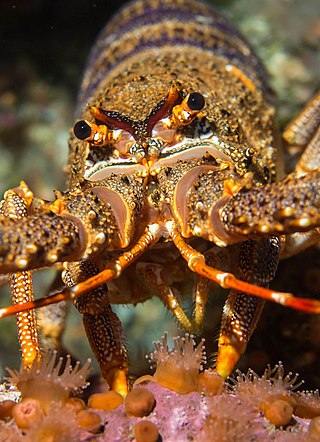George Sprague Myers was an American ichthyologist who spent most of his career at Stanford University. He served as the editor of Stanford Ichthyological Bulletin as well as president of the American Society of Ichthyologists and Herpetologists. Myers was also head of the Division of Fishes at the United States National Museum, and held a position as an ichthyologist for the United States Fish and Wildlife Service. He was also an advisor in fisheries and ichthyology to the Brazilian Government.
Bascanichthys is a genus of eels in the snake eel family Ophichthidae. It currently contains the following species:

Nessorhamphus ingolfianus, the duckbill oceanic eel, duckbilled eel or Ingolf duckbill eel,) is an eel in the family Derichthyidae. It was described by Johannes Schmidt in 1912. It is a marine, deep water-dwelling eel which is known from France, Morocco, the Cape of Good Hope, and South Africa in the eastern Atlantic Ocean, as well as from the western Atlantic, southwestern Indian, and southwestern Pacific. It dwells at a depth range of 0–1,800 metres (0–5,900 ft), inhabiting the mesopelagic zone. Males can reach a maximum total length of 58.9 centimetres.

The sooty eel is an eel in the family Ophichthidae. It was described by David Starr Jordan in 1884, originally under the genus Caecula. It is a marine, subtropical eel which is known from the western Atlantic Ocean, including North Carolina and Florida, USA, and the Gulf of Mexico. It dwells at a depth range of 0 to 27 metres. Males can reach a maximum total length of 70 centimetres (2.3 ft).
The Sooty sand-eel is an eel in the family Ophichthidae. It was described by Raymond Carroll Osburn and John Treadwell Nichols in 1916. It is a marine, tropical eel which is known from the eastern central Pacific Ocean, including Costa Rica and Mexico. It is known to dwell at a maximum depth of 20 metres (66 ft), and inhabits sand sediments. Males can reach a maximum total length of 77 centimetres (30 in).
Bascanichthys ceciliae is an eel in the family Ophichthidae. It was described by Jacques Blache and Jean Cadenat in 1971. It is a tropical, marine eel which is known from the eastern coastal Atlantic Ocean between Senegal and Angola. It inhabits shallow waters where it burrows in sand; the burrows are sometimes exposed during low tide. It can reach a maximum total length of 82.5 centimetres, but more commonly reaches a TL of 60 cm.
The Indian longtailed sand-eel is an eel in the family Ophichthidae. It was described by Ambat Gopalan Kutty Menon in 1961. It is a marine, tropical eel which is known from the Pacific and Indian Ocean, including India and Sri Lanka. It inhabits river mouths and lagoons. Males can reach a maximum total length of 60 centimetres (24 in).
Bascanichthys fijiensis is an eel in the family Ophichthidae. It was described by Alvin Seale in 1935. It is a tropical, marine eel which is known from Fiji, in the western central Pacific Ocean.
Bascanichthys filaria is an eel in the family Ophichthidae. It was described by Albert Günther in 1872. It is a tropical, marine eel which is known from Irian Jaya, Indonesia, in the western central Pacific Ocean.
Bascanichthys inopinatus, the unexpected snake eel, is an eel in the family Ophichthidae. It was described by John E. McCosker, Eugenia Brandt Böhlke, and James Erwin Böhlke in 1989. It is a tropical, marine eel endemic to the coastal marine waters of Puerto Rico.
The Longtailed sand-eel is an eel in the family Ophichthidae. It was described by Albert Günther in 1870, originally under the genus Ophichthys. It is a marine, tropical eel, which is known from Aden to Natal, South Africa, in the western Indian Ocean. Males can reach a maximum total length of 54 centimetres (21 in).
Bascanichthys myersi is an eel in the family Ophichthidae. It was described by Albert William Herre in 1932. It is a tropical, marine eel which is known from the western central Pacific Ocean, including Dumaguete, Negros Oriental, in the Philippines.
The Panama sand-eel is an eel in the family Ophichthidae. It was described by Seth Eugene Meek and Samuel Frederick Hildebrand in 1923. It is a marine, tropical eel which is known from the eastern central Pacific Ocean, including the Gulf of California, Mexico, Costa Rica, Panama, and Nicaragua. It dwells at a maximum depth of 30 metres (98 ft), and inhabits sandy sediments, sometimes in estuaries and mangroves. Males can reach a maximum total length of 76 centimetres (30 in).
Bascanichthys pusillus is an eel in the family Ophichthidae. It was described by Alvin Seale in 1917. It is a tropical, marine eel which is known from the western central Pacific Ocean.
The whip eel is an eel in the family Ophichthidae. It was described by George Brown Goode and Tarleton Hoffman Bean in 1880. It is a marine, subtropical eel which is known from the western Atlantic Ocean, including the United States and the Gulf of Mexico. It inhabits reefs and coastal waters. Males can reach a maximum total length of 76 centimetres (30 in).
The Siboga snake eel is an eel from the family Ophichthidae. It was described by Max Carl Wilhelm Weber in 1913, originally under the genus Callechelys. It is a marine, tropical eel which is found off the south coast of Timor, Indonesia, in the western central Pacific Ocean. Males can reach a maximum total length of 23.7 centimetres (9.3 in).

Echiophis punctifer, the stippled spoon-nose eel, spoon-nose eel or snapper eel, is an eel in the family Ophichthidae. It was described by Johann Jakob Kaup in 1859. It is a marine, tropical eel which is known from the western and eastern Atlantic Ocean, including the Gulf of Mexico, Cuba, northern South America, Senegal, and Angola. It dwells at a depth range of 40 to 100 metres, and inhabits shallow bays and lagoons, in which it forms burrows in mud and sand. Males can reach a maximum total length of 180 centimetres (71 in), but more commonly reach a TL of 100 centimetres (39 in).

The goldspotted eel, also known as the goldspotted snake eel or the dark-spotted snake eel, is an eel in the family Ophichthidae. It was described by Charles Alexandre Lesueur in 1825, originally under the genus Muraenophis. It is a marine, tropical eel which is known from the western and eastern Atlantic Ocean, including Bermuda, southern Florida, USA; the Bahamas, Santa Catarina, and Brazil. It dwells at a maximum depth of 15 metres (49 ft), and inhabits rocky and coral reefs. Males can reach a maximum total length of 110 centimetres (3.6 ft).

Jasus paulensis, also commonly known as the St Paul rock lobster, is a species of spiny lobster found in the waters around Saint Paul Island in the southern Indian Ocean and around Tristan da Cunha in the southern Atlantic Ocean. At one time the rock lobsters on Tristan da Cunha were believed to be a separate species known as the Tristan rock lobster, but the use of mitochondrial DNA sequencing has shown them to be identical. Some authorities, for example the International Union for Conservation of Nature, retain them as separate species. The Tristan rock lobster features on the coat of arms and the flag of Tristan da Cunha.
Margaret Hamilton Storey was an American museum curator, herpetologist and ichthyologist. She worked for the Stanford University Natural History Museum for over 25 years.





